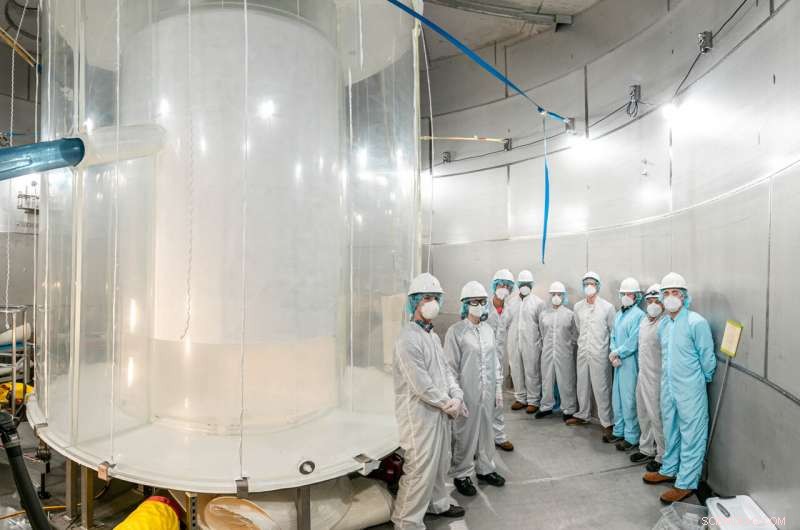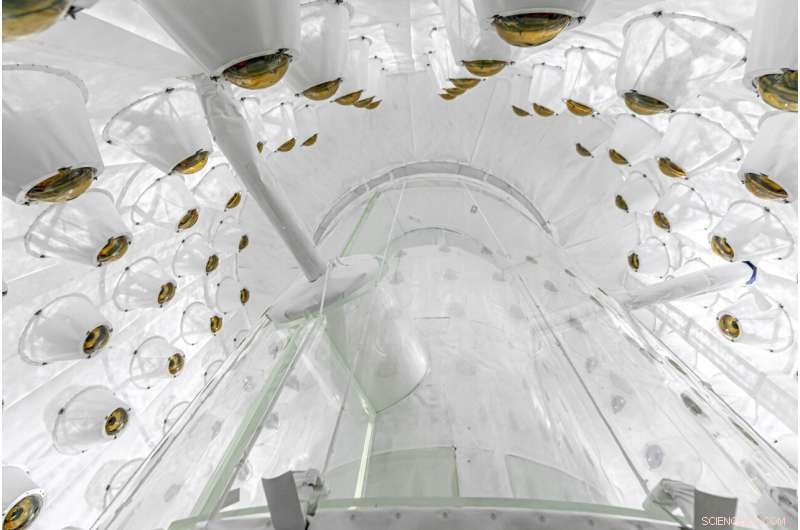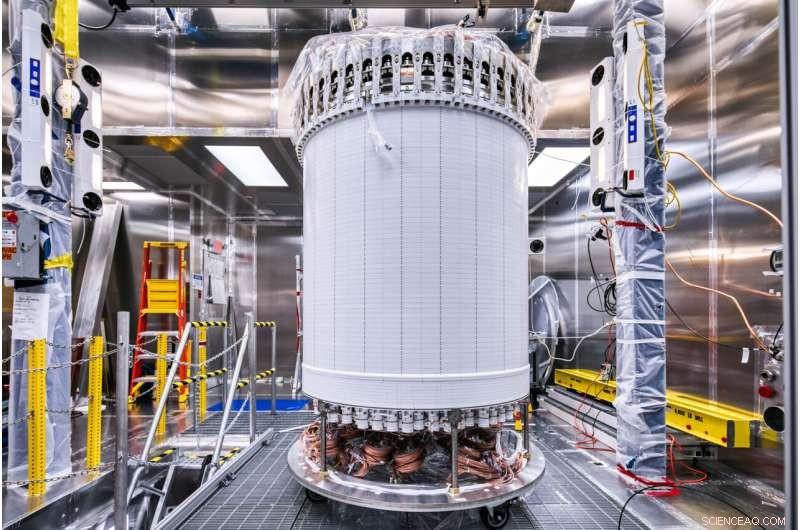Pesquisadores registram inicialização bem-sucedida de detector de matéria escura em instalação de pesquisa subterrânea

Membros da equipe LZ no tanque de água LZ após a instalação do detector externo. Crédito:Matthew Kapust/Sanford Underground Research Facility
Nas profundezas das Black Hills da Dakota do Sul, no Sanford Underground Research Facility (SURF), um detector de matéria escura inovador e excepcionalmente sensível - o experimento LUX-ZEPLIN (LZ), liderado pelo Lawrence Berkeley National Lab (Berkeley Lab) - passou por um fase de check-out das operações de inicialização e entrega dos primeiros resultados.
A mensagem para levar para casa desta startup de sucesso:"Estamos prontos e tudo parece bem", disse o físico sênior do Berkeley Lab e ex-porta-voz da LZ, Kevin Lesko. "É um detector complexo com muitas peças e todas estão funcionando bem dentro das expectativas", disse ele.
Em um artigo publicado on-line hoje no site do experimento, os pesquisadores do LZ relatam que, com a execução inicial, o LZ já é o detector de matéria escura mais sensível do mundo. O artigo aparecerá no arquivo de pré-impressão online arXiv.org ainda hoje. O porta-voz da LZ, Hugh Lippincott, da Universidade da Califórnia em Santa Bárbara, disse:"Planejamos coletar cerca de 20 vezes mais dados nos próximos anos, então estamos apenas começando. Há muita ciência para fazer e é muito empolgante".
Partículas de matéria escura nunca foram realmente detectadas – mas talvez não por muito mais tempo. A contagem regressiva pode ter começado com os resultados dos primeiros 60 "dias ao vivo" de testes da LZ. Esses dados foram coletados ao longo de um período de três meses e meio de operações iniciais a partir do final de dezembro. Este foi um período longo o suficiente para confirmar que todos os aspectos do detector estavam funcionando bem.
Invisível, porque não emite, absorve ou espalha luz, a presença da matéria escura e a atração gravitacional são fundamentais para nossa compreensão do universo. Por exemplo, a presença de matéria escura, estimada em cerca de 85% da massa total do universo, molda a forma e o movimento das galáxias, e é invocada por pesquisadores para explicar o que se sabe sobre a estrutura e expansão em grande escala. Do universo.

Olhando para o LZ Outer Detector, usado para vetar radioatividade que pode imitar um sinal de matéria escura. Crédito:Matthew Kapust/Sanford Underground Research Facility
O coração do detector de matéria escura LZ é composto por dois tanques de titânio aninhados cheios de dez toneladas de xenônio líquido muito puro e visualizados por dois conjuntos de tubos fotomultiplicadores (PMTs) capazes de detectar fontes fracas de luz. Os tanques de titânio residem em um sistema detector maior para capturar partículas que podem imitar um sinal de matéria escura.
“Estou emocionado ao ver este detector complexo pronto para resolver a questão de longa data de que matéria escura é feita”, disse a diretora da divisão de física do Berkeley Lab, Nathalie Palanque-Delabrouille. "The LZ team now has in hand the most ambitious instrument to do so."
The design, manufacturing, and installation phases of the LZ detector were led by Berkeley Lab project director Gil Gilchriese in conjunction with an international team of 250 scientists and engineers from over 35 institutions from the US, UK, Portugal, and South Korea. The LZ operations manager is Berkeley Lab's Simon Fiorucci. Together, the collaboration is hoping to use the instrument to record the first direct evidence of dark matter, the so-called missing mass of the cosmos.
Henrique Araújo, from Imperial College London, leads the UK groups and previously the last phase of the UK-based ZEPLIN-III program. He worked very closely with the Berkeley team and other colleagues to integrate the international contributions. "We started out with two groups with different outlooks and ended up with a highly tuned orchestra working seamlessly together to deliver a great experiment," Araújo said.
An underground detector Tucked away about a mile underground at SURF in Lead, S.D., LZ is designed to capture dark matter in the form of weakly interacting massive particles (WIMPs). The experiment is underground to protect it from cosmic radiation at the surface that could drown out dark matter signals.

(Left) A schematic of the LZ detector. (Right) Illustration of LZ operation—particles interact in liquid xenon, releasing a flash of light and charge that are collected by photomultiplier tube arrays at top and bottom. Credit:Left schematic:LZ collaboration. Right image:LZ/SLAC
Particle collisions in the xenon produce visible scintillation or flashes of light, which are recorded by the PMTs, explained Aaron Manalaysay from Berkeley Lab, who as physics coordinator, led the collaboration's efforts to produce these first physics results. "The collaboration worked well together to calibrate and to understand the detector response," Manalaysay said. "Considering we just turned it on a few months ago and during COVID restrictions, it is impressive we have such significant results already."
The collisions will also knock electrons off xenon atoms, sending them to drift to the top of the chamber under an applied electric field where they produce another flash permitting spatial event reconstruction. The characteristics of the scintillation help determine the types of particles interacting in the xenon.
Mike Headley, executive director of SURF Lab, said, "The entire SURF team congratulates the LZ Collaboration in reaching this major milestone. The LZ team has been a wonderful partner and we're proud to host them at SURF."
Fiorucci said the onsite team deserves special praise at this startup milestone, given that the detector was transported underground late in 2019, just before the onset of the COVID-19 pandemic. He said with travel severely restricted, only a few LZ scientists could make the trip to help on site. The team in South Dakota took excellent care of LZ.
"I'd like to second the praise for the team at SURF and would also like to express gratitude to the large number of people who provided remote support throughout the construction, commissioning and operations of LZ, many of whom worked full time from their home institutions making sure the experiment would be a success and continue to do so now," said Tomasz Biesiadzinski of SLAC, the LZ detector operations manager.

The LZ central detector in the clean room at Sanford Underground Research Facility after assembly, before beginning its journey underground. Credit:Matthew Kapust, Sanford Underground Research Facility
"Lots of subsystems started to come together as we started taking data for detector commissioning, calibrations and science running. Turning on a new experiment is challenging, but we have a great LZ team that worked closely together to get us through the early stages of understanding our detector," said David Woodward from Pennsylvania State University, who coordinates the detector run planning.
Maria Elena Monzani of SLAC, the Deputy Operations Manager for Computing and Software, said, "We had amazing scientists and software developers throughout the collaboration, who tirelessly supported data movement, data processing, and simulations, allowing for a flawless commissioning of the detector. The support of NERSC [National Energy Research Scientific Computing Center] was invaluable."
With confirmation that LZ and its systems are operating successfully, Lesko said, it is time for full-scale observations to begin in hopes that a dark matter particle will collide with a xenon atom in the LZ detector very soon.
+ Explorar mais A major milestone for an underground dark matter search experiment



